Don't wanna be here? Send us removal request.
Text
Why is TikTok Dashboard So Important for Understanding Your Performance?
The TikTok dashboard is a powerful tool for content creators and marketers, offering a comprehensive view of performance metrics and insights. Using this user-friendly dashboard template, you can gain a practical understanding of how your content performs on the platform. In this article, we will explore the importance of the TikTok dashboard and how it can enhance your content strategy.
Overview of TikTok Data and Metrics
A TikTok dashboard provides a centralized location to view and analyze key data and metrics. Understanding how your content is resonating with your audience is crucial. You can unlock detailed insights and real-time performance tracking by following simple instructions. Metrics such as views, likes, shares, and comments clearly show what works and what doesn’t, allowing you to make data-driven decisions and refine your content strategy for better engagement.

Real-Time Performance Tracking
One of the standout features of the TikTok dashboard is considered to be its ability to offer real-time performance tracking. The ability to offer real-time performance tracking should be one of the standout features of the TikTok dashboard. Monitoring your videos’ performance immediately after posting is invaluable as it enables you to react quickly to trends and audience preferences. If a particular video gains traction, you can capitalize on its momentum by creating similar content. Conversely, if a video is underperforming, you can swiftly adjust your strategy to improve future posts.
Audience Engagement and Follower Growth
Tracking audience engagement and follower growth is essential for any TikTok creator. The dashboard template should allow you to measure these metrics accurately. Analyzing engagement rates helps you identify what type of content your audience prefers, including understanding which videos get the most comments, shares, and likes. Additionally, tracking follower growth helps gauge the overall health of your TikTok account. A constant increase in followers indicates that your content attracts and retains viewers, while a plateau or decline may signal the need for a content overhaul.
Optimizing Posting Schedule
Timing is crucial on TikTok, and the dashboard can help you to determine the best times to post content. Analyzing when your audience is most active allows you to optimize your posting schedule to ensure your videos reach the maximum number of viewers. This increases the likelihood of engagement and can help your content go viral. The Looker Studio TikTok analytics dashboard by Coupler.io template provides these insights, enabling you to schedule posts strategically and maximize their impact.

Identifying Top-Performing Content
Not all content performs equally on TikTok; the dashboard can help you to identify your top-performing videos. Highlighting these successes allows you to learn what elements contribute to their popularity. This might include specific trends, hashtags, video length, or even the time of posting. Understanding these factors enables you to replicate successful strategies and avoid those that don’t resonate with your audience, significantly boosting your overall performance on the platform over time.
Conclusion
The TikTok dashboard is an indispensable tool for any content creator or marketer looking to succeed on the platform. Offering a comprehensive view of critical data and metrics, real-time performance tracking, and insights into audience engagement and follower growth is key to enhancing your TikTok strategy. You can succeed tremendously by identifying top-performing content and optimizing your posting schedule. Utilizing the user-friendly Looker Studio TikTok analytics dashboard template allows you to unlock detailed insights and take your TikTok game to the next level.
0 notes
Text
10 Best Marketing Analytics Tools to Use in 2024
Business owners and marketers frequently gather customer and competitor data for targeted marketing efforts, trend identification, issue/opportunity spotting, and decision-making. Marketing analytics involves utilizing tools like data analytics, business intelligence, dashboards, and reporting. Streamlining this process is achievable through dedicated marketing analytics software. In this article, let’s explore top options, detailing features, benefits, and reliability.

10 best marketing analytics tools you can consider
There are many marketing analytics tools out there that promise to process and extract valuable insights from your marketing data. So, to help you choose an appropriate tool for your business, let’s see a list of the top 10 marketing analytics tools.
Coupler.io — a platform for data automation, analytics, and reporting
Coupler.io is a comprehensive data automation and analytics platform that empowers efficient data management. It enables the collection, transformation, and analysis of marketing data for informed decision-making. While not a direct marketing tool, it facilitates marketing analytics and reporting tasks.
Key features include a number of marketing sources to extract data from, like Google Analytics 4, Facebook Ads, Mailchimp, and others. Coupler.io also integrates with Looker Studio for customized analytical reports and automation. Alternatively, it seamlessly connects marketing sources to other BI tools such as Tableau or Power BI.
Moreover, Coupler.io offers data analytics consultancy services, addressing diverse data-related challenges, including advanced visualization and setting up data infrastructure.
2. Optimizely
Optimizely serves as a versatile digital experience platform, encompassing content creation, e-commerce management, and experimentation for optimizing customer interactions.
The platform includes robust features for content management throughout its lifecycle. From campaign assistance through the Content Marketing Platform to enhancing digital experiences via the Content Management System, Optimizely provides comprehensive support.
For e-commerce endeavors, Optimizely offers AI-powered tools for personalized experiences and product recommendations, enhancing business management capabilities and fostering customer engagement.
With its experimentation tools, Optimizely enables thorough evaluation of customer touchpoints. Through Web Experimentation, users can conduct tests to glean insights and refine user experiences, while Feature Experimentation aids in validating new features and ensuring high-quality releases.
3. Heap
Heap is a marketing analytics platform designed to provide comprehensive insights into customer digital experiences, aiding in enhancing conversion rates, retention, and satisfaction.
Key features include session replay, enabling users to visualize user interactions and identify moments of friction. It also facilitates the discovery of potential issues and opportunities within the product’s digital experience, helping to avoid confirmation bias and erroneous decisions.
Additionally, Heap allows for the creation of user segments to understand diverse user behaviors and personalize their journeys. It supports dashboard creation for monitoring metrics and sharing insights while offering auto-capture, custom tracking, and server-side event capabilities for robust behavioral data collection. Moreover, Heap offers cross-platform analytics, ensuring seamless monitoring of digital experiences across web and mobile platforms, and integrates with various business software tools for enhanced functionality.
4. TapClicks
TapClicks serves as a comprehensive marketing analysis tool encompassing workflow and project management, big data integration, insights, analytics, and reporting.
Key features include tapAnalytics, enabling the analysis of campaign performance by uncovering hidden trends and opportunities. It facilitates data calculations, consolidation from multiple sources, goal and budget tracking, as well as lead and data load status management.
TapClicks offers tapData for automated data pipeline management, aggregating, blending, and transferring data from over 6000 sources to popular destinations such as BigQuery, Snowflake, and S3. It provides dimension, filter, and flexible data control options for data refinement. Additionally, tapReports allows users to create impactful reports and dashboards displaying KPIs and statistics, with features for adding recipients and scheduling report delivery.
5. Mixpanel
Mixpanel is an advanced user behavior analytics platform empowering data-driven decision-making for businesses. This marketing analytics tool provides insights into user interactions with products, aiding in informed decision-making to enhance user engagement and retention.
Key features of Mixpanel include event tracking, enabling the monitoring of individual user interactions across multiple touchpoints. It also offers funnels and retention analysis to understand user journeys, pinpoint drop-offs, and assess user retention comprehensively.
Mixpanel provides predictive analytics utilizing machine learning algorithms to forecast user behavior and optimize marketing strategies effectively. User segmentation capabilities allow businesses to categorize users based on behavior and attributes, enabling targeted marketing efforts. Additionally, Mixpanel integrates seamlessly with various other tools, including CRMs and email marketing platforms, for enhanced functionality.
6. Buffer
Buffer is a comprehensive social media management tool that simplifies the process of scheduling posts across various platforms such as Twitter, allowing users to efficiently plan and manage content from a single dashboard. Additionally, it serves as a valuable marketing analytics software, enabling analysis of post-performance and other social media marketing activities.
Key features of Buffer include post scheduling, facilitating the organization, and management of social media posts across different platforms within one centralized dashboard. It also offers social media performance analytics, allowing users to assess the effectiveness of their posts and refine their social media strategy accordingly.
Moreover, Buffer provides multi-account management capabilities, enabling users to oversee multiple social media accounts from a single platform. Team collaboration features allow for seamless teamwork on social media campaigns, while custom reports offer detailed insights into social media performance, aiding in the optimization of marketing strategies. Integration with other digital marketing tools further streamlines processes, enhancing overall efficiency.
7. Google Analytics 4
GA4, the successor of Google Analytics Universal, serves as a powerful web analytics tool assisting businesses in comprehending user interactions with their websites and apps.
Key features of Google Analytics 4 include user-centric measurement, allowing businesses to track customer journeys across various devices and platforms in a privacy-conscious manner. Unlike its predecessor, GA4 emphasizes customer-centric measurement over device-centric tracking.
Enhanced audience-building capabilities enable the creation of audiences based on user behavior, demographics, and technological attributes. These audiences can be analyzed within GA4 or exported to Google Ads for remarketing campaigns. Additionally, GA4 offers codeless event tracking, allowing users to configure specific events directly from the user interface without the need for additional code on their site or app.
GA4 incorporates data-driven attribution models powered by machine learning, facilitating the assignment of credit to touchpoints in the customer journey. This enables businesses to gain insights into which marketing efforts are driving the most significant results, aiding in strategic decision-making and campaign optimization.
Additionally, businesses can easily export data from GA4 to Power BI, allowing for seamless integration and comprehensive analysis of web and app analytics within Power BI’s powerful reporting environment.
8. Looker Studio
Looker Studio offers a versatile solution for transforming raw data into actionable insights, facilitating informed decision-making across various domains. With its customizable dashboards and reports, users can efficiently monitor key metrics and trends derived from data collected from CRMs, email software, and other marketing applications. This simplifies data analysis and enhances the accessibility of insights for all stakeholders, not just data scientists.
Key features of Looker Studio include customizable dashboards and reports, enabling users to create tailored marketing dashboards to track essential metrics and streamline reporting processes. Additionally, its data modeling capabilities empower users to understand intricate relationships and patterns within their datasets, further enhancing data analysis efficiency.
Furthermore, Looker Studio offers seamless integration with various data sources and business tools, ensuring compatibility and interoperability across platforms. Users can leverage native or third-party connectors, such as Coupler.io, to integrate Looker Studio with other business tools and data sources effortlessly, expanding its utility and versatility within organizational workflows.
9. Contentsquare
Contentsquare stands out as a robust digital experience analytics platform dedicated to offering businesses profound insights into user interactions across websites, mobile apps, and other digital products. Leveraging machine learning algorithms, often referred to as AI in marketing parlance, Contentsquare delivers predictive analytics aimed at enhancing customer experience and fostering growth.
Key features of Contentsquare include user journey analysis, allowing businesses to scrutinize user paths to pinpoint friction points and optimization opportunities. Through session replay, users can delve into individual user sessions to gain nuanced insights into user behavior. Heatmaps provide visual representations of user interactions, offering clarity on areas of interest and potential issues within digital interfaces.
Moreover, Contentsquare offers conversion funnel analysis, enabling businesses to track user behavior through the conversion process and identify points of abandonment. Its predictive analytics capabilities harness AI to forecast future user behavior and trends. Additionally, Contentsquare boasts integration capabilities with various digital tools, including CRM systems, e-commerce platforms, and analytics tools, ensuring seamless compatibility and data flow across platforms.
10. Plerdy
Plerdy serves as a comprehensive conversion rate optimization solution, equipping businesses with essential tools to monitor and enhance their online performance. These tools, including session replay and heatmaps, offer valuable insights into website usability and facilitate increased conversions.
Key features of Plerdy encompass session replay, enabling businesses to monitor visitor behavior and detect anomalies, providing precise insights into user interactions on selected web pages. Heatmaps visualize user behavior, shedding light on areas of interest and potential friction points within the website interface.
Plerdy offers event-tracking functionality, allowing businesses to monitor user-specific actions such as clicks and form submissions. This aids in evaluating website design effectiveness and identifying issues that may contribute to high vain click rates. Additionally, Plerdy provides conversion funnel analysis, enabling businesses to scrutinize user behavior throughout the conversion process, pinpointing drop-off points and optimization opportunities.
Leverage marketing analytics tools to enhance decision-making processes
Integral to every marketing campaign, analytics aids in issue identification and swift action, facilitating data-driven decision-making within your business.
An optimal marketing analytics platform should enable comprehensive data collection from diverse sources, facilitate categorization, and interpretation through dashboards, automate report generation, and accommodate multiple users for enhanced collaboration and efficiency.
0 notes
Text
Maximizing Productivity: Unveiling Insights with Google Calendar Dashboard (+ free template)
In a year filled with countless meetings and competing priorities, gaining a clear perspective on your time allocation is crucial. Having a user-friendly dashboard to recap your calendar activities would help to better understand your schedule, optimize your time, and make data-driven decisions.
Introducing an innovative calendar analytics tool designed to seamlessly integrate with your schedule and provide valuable insights into your time management. This versatile Google Calendar dashboard template offers a comprehensive overview of your events, allowing you to analyze past scheduling patterns, enhance productivity, and make informed decisions for the future.

By following the easy-to-use instructions within the template, users can quickly generate a summary of their activities for a desired period, gaining a deeper understanding of the effectiveness of their scheduling strategies over the past year. Identify trends, assess time spent in meetings, and uncover key metrics that impact your daily agenda.
Take control of your schedule by discovering who influences your meeting calendar most. Identify top meetings and their organizers effortlessly, shedding light on how your time is allocated and enabling you to make data-driven adjustments for improved efficiency.
This ready-to-use analytical tool eliminates the need for complex setups. Connect the dashboard to your Google Calendar with a few clicks and start tracking essential meeting metrics. The integration with Coupler.io ensures automated data refreshment, keeping your charts up-to-date with the latest information from your calendar. Set your preferred refresh frequency, with updates as frequently as every 15 minutes.
Customize the white-label template to fit your needs, adjusting metrics and visuals to align with your preferences. Share valuable calendar insights with colleagues at the click of a button, fostering collaboration and informed decision-making.
Discover the power of understanding your schedule, optimizing your time, and making data-driven decisions. Try it for free and revolutionize how you manage your time in the current year and beyond!
#data analytics#data visualization#dashboards#dashboard templates#reporting#looker studio#google calendar#google calendar template#google calendar dashboard#time management#productivitytips#productivity
0 notes
Text
Explore 10 Company Financial Dashboards with Examples & Free Templates
This article presents a variety of financial dashboards, ranging from a CFO financial dashboard to a revenue overview and cashflow forecast. These dashboards are designed to assist you in comprehending your financial data effectively.
Among them, some serve as inspiration for crafting a personalized dashboard, while others are pre-made templates ready for immediate use. The latter enables you to effortlessly visualize your financial data within minutes. Additionally, we will guide you on automating your financial dashboard reporting, ensuring that your dashboards remain current and ready for analysis.
10 financial dashboard examples
1. SaaS financial dashboard + template
Utilize this dashboard to:
Discern the key drivers influencing financial outcomes
Identify current and potential obstacles
Examine the impact of sales on revenue generation
Monitor the evolving dynamics of revenue over time
Investigate the causes of revenue loss
Fine-tune your strategy to enhance financial performance
This dashboard is available as a free template for different apps:
Financial dashboard template for HubSpot
Financial dashboard template for Pipedrive
Financial dashboard template for Salesforce
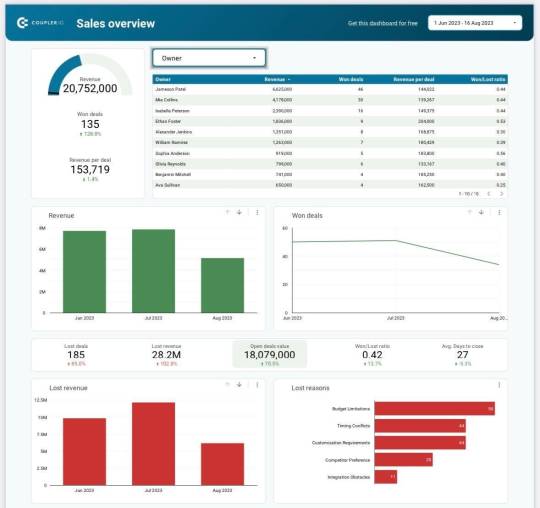
2. Billing overview dashboard + template
Similar to contemporary financial reporting dashboards, this visually presented report is automatically updated, interactive, and conducive to analysis. It empowers you to:
Delve deeply into your data
Employ diverse filters and delve into specific details
Real-time monitoring of billing statuses
Recognition of top-performing projects and clients
Efficient billing management
Analysis of profits over time from different perspectives
This Billing overview dashboard is available as a free template.
3. CFO financial dashboard + template
Utilizing this template for a financial reporting dashboard, you can:
Track near-real-time revenue growth
Discern the top-performing products
Maintain a comprehensive record of invoices
Analyze financial data for actionable insights
Formulate data-supported projections and plan for the future
This Financial dashboard for QuickBooks is available as a free template.

4. Ecommerce financial reporting dashboard + template
Utilize this dashboard to:
Gain insights into the overall business performance of your store
Analyze and enhance order management for revenue maximization
Filter orders based on country and source
Filter orders according to their financial status (paid, pending, refunded, etc.)
Foster alignment among your finance, marketing, and sales teams to enhance overall strategy
This Ecommerce financial reporting dashboard is available as a free template.
5. Financial performance dashboard
Utilize this dashboard to:
Monitor revenue in relation to established targets
Swiftly observe shifts in growth trends
Compare actual revenue to your projections
Assess overall financial health at a glance
This dashboard was built in Tableau by MergeYourData and designed to serve as a cockpit, giving several graphs and multiple scorecards presenting various aspects of financial performance.
6. Cashflow tracking dashboard
With this dashboard, you can:
Track the dynamics of cashflow over time
Visualize the contribution of various products to cashflow (annual/monthly subscriptions)
Identify trends and patterns
Perform time-over-time analysis
This type of dashboard example is a Cashflow report built in PowerBI.
7. MRR breakdown dashboard
With this dashboard, you can:
Monitor and analyze Monthly Recurring Revenue (MRR) data
Uncover trends and significant factors impacting MRR
Perform month-over-month comparison analysis
Keep tabs on crucial metrics like churn or reactivation
Extract valuable insights to integrate into your strategy
Incorporate financial analytics into your regular processes
You can check this example of MRR breakdown dashboard for a better understanding.
8. Product revenue dashboard
Utilize this product Key Performance Indicator (KPI) dashboard to:
Monitor and analyze product revenue
Effectively manage churn
Gain deeper insights into Monthly Recurring Revenue (MRR) trends
Conduct financial analysis related to product performance
9. Daily cashflow forecast dashboard + template
With this template, you can:
Create forecasts for various time frames
Perform cashflow analysis
Develop strategies to attain the projected outcomes
Make well-informed decisions
This Ecommerce financial reporting dashboard is available as a free template.
10. High-level revenue and profit dashboard
Utilize this dashboard to:
Monitor essential metrics such as total revenue, gross profit margin, net profit margin, and more
Track month-to-month variations
Access the latest financial data around the clock
Maximize decision speed with effective financial dashboards. These dashboards serve diverse purposes, acting as reporting tools, KPI monitoring cockpits, and data analysis instruments. To be genuinely effective, a dashboard must be tailored to specific goals and audience preferences and live auto-updating with interactive features like filters and drill-downs. Including only relevant metrics, an excellent financial dashboard becomes a powerful tool for decision-makers, facilitating KPI monitoring, process control, progress tracking, and more.
This article showcases examples of automated finance dashboards with real-time data, providing actionable insights and encouraging a data-driven approach. Apart from financial, click here to learn how to build other types of SaaS dashboards and unlock your data’s full potential for informed decision-making.
#dashboards#dashboard templates#data analytics#data visualization#reporting#finance#financial data analytics#financial dashboards#financial reporting#financial data
0 notes
Text
Marketing Data Integration: Definition, Importance, Use Cases
Any digital marketer (be it an SEO, PPC expert, or other specialist) operates with lots of marketing records, metrics, documents, etc. And we all know how it can be long and tiring to collect those records and then analyze them, especially if they're distributed in different tools.
That's why marketers use the capabilities of marketing data integrations, which help them streamline the collection, organization, and analysis of marketing activities.
In this post, I'd like to overview the importance, challenges, and use cases of marketing data integration. Let's start!
Definition of marketing data integration
Marketing data integration is a consolidation of marketing data from various sources. For example,
website analytics tools
email marketing platforms
social media
ad platforms
ERPs
CRMs
others
This data goes into a single space. The integrations provide marketers with a comprehensive and cohesive view of leads, customers, campaigns, traffic sources, subscribers, conversions, impressions, engagements, and more.
So, integrating marketing data is a valuable tool for targeted marketing strategies, gaining insights into standout company actions, evaluating marketing endeavors, and facilitating informed decision-making.
The key challenge of marketing integrations
The primary challenge of combined data includes the manual extraction uploading process, which takes lots of time.
In parallel, automation can be a solid solution to this challenge. Automation not only simplifies the integration process but also frees up significant time for marketers to analyze data and focus on more critical tasks.
Further, I'll share an example of automation's impact on marketing data integration and data evaluation. But now, let's discuss the importance of marketing integrations.
Importance of marketing data integrations for businesses
In marketing, data integrations provide a set of benefits. I'd go with the three most crucial.
Unification of marketing analytics. If your company invests in data integration for marketing, you'll have access to fresh and correct data in one location. It also helps reduce errors in manual data processing. With your data automatically updated and stored in a data warehouse or fetched into a dashboard, you decrease the level of complexity related to analysis.
Eventually, you'll have the clarity of the data improved since there'll be a consolidated picture of all marketing data inside an organization. This is particularly important for making marketing decisions, changing strategies, experimenting with various approaches – clear, accessible real-time data is a way to improve your marketing analytics and performance.
Understanding target audience. By fetching data from various marketing channels and sources, you can have a comprehensive understanding of your customers, create an ICP.
For instance, by checking data from website analytics tools, you see how visitors interact with your website and blog, what pages they check, etc. If you're running social media ads, a Facebook Ads reporting tool can store your data and visualize your data so you can check key metrics and how people engage with your ads.
So data integration for marketing collects crucial information piece by piece, eventually offering a marketer a broad picture of customer behavior and ways of attracting new leads.
Transparency and teamwork. When your data is integrated, the marketing team has access to all the needed assets. It makes the entire team to be on the same page. This fosters collaboration as team members can collectively analyze and interpret data.
Also, rapid access to relevant information empowers marketers to make agile decisions, ensuring that strategies align with current market dynamics.
Further, it saves time since there's no need to manually give/check access and copy-paste data. All these can positively impact the team's productivity.
Use cases of marketing data integrations
I've shared a few examples above, but I'd like to present a few more practical implementations of data integrations in marketing.
At our company, we use different channels for paid advertising: Google Ads, Bing Ads, Facebook Ads, and LinkedIn Ads. It’s important for us to track our expenses and the results of campaigns, and it’s so much easier if we can have it all in one place. This is where marketing data integration comes into play.
We have a unified dashboard with key metrics (CPC, CPA, CAC, and others) per each campaign and platform. It's easy to track the performance of every campaign to make adjustments in the following campaigns. The dashboard is updated automatically.

Another use case: a business connects its CRM system with the email marketing platform and buyers database. By integrating marketing data in this way, the company achieves a smooth synchronization of customer details, purchase history, and email engagement data.
This integration empowers marketers to craft tailored email campaigns, drawing insights from customers' previous purchases, preferences, and interactions. The outcome is more personalized and impactful marketing strategies. Moreover, the integration offers a consolidated perspective on customer data.
There might be way more use cases of marketing data integrations based on individual needs. You can play with different combinations of platforms to connect and get the data automatically. Even more, you can dive into the world of more advanced marketing data integrations when you connect marketing data sources with accounting software, sales tools, etc.
Conclusion
The topic and importance of marketing data integration are vast. In this brief overview, I wanted to highlight key aspects of data integrations for marketing.
In short, there's a lot of marketing data, even in a small business doing marketing. This data has to be collected and analyzed for growth and profitability. That's why marketing data integrations are worth attention.
Check more narrow topics on marketing analytics, data, and visualization here. And consider automating and optimizing your work with marketing data.
Author bio:
Zakhar Yung is a Content Manager at Coupler.io. He has over 5 years of experience in content marketing. Apart from that, Zakhar is a data analytics and marketing enthusiast.
#digital marketing#data analytics#data visualization#reporting#marketing data#data integration#marketing data integration#marketing dashboards
1 note
·
View note
Text
Enhancing ROI with a Revenue Dashboard: Templates, Examples, and Best Practices
Envision a scenario where all financial reporting within your company is effortlessly automated. Imagine having consistently ready and updated reports, complemented by a flawless revenue dashboard showcasing only the latest data — without the need for a single click. Sounds promising, doesn’t it? Let’s explore how you can achieve this.
Top 5 Revenue Dashboard Examples
Revenue Analysis Dashboard (+ Free Template)
Interactive and automated, focusing on key metrics for day-to-day monitoring.
Live data refresh ensures up-to-date information.
Facilitates continuous monitoring, trend identification, and data-driven decision-making.
Free template: Revenue dashboard for QuickBooks

Sales Revenue Dashboard (+ Free Templates)
Explores sales performance metrics, tracking revenue towards financial goals.
Interactive, automated, and suitable for Pipedrive or HubSpot users.
Provides a comprehensive overview of sales activity and team performance.
Free template: Sales revenue dashboard for HubSpot
Free template: Sales revenue dashboard for Pipedrive
Product Revenue Summary Dashboard
Granular overview of product revenue, including MRR, ARR, and monthly sales.
Enables period-over-period analysis and in-depth revenue trend monitoring.
Monthly Recurring Revenue Breakdown
Detailed analysis of MRR growth over several years.
Highlights regular MRR, churn, new, and reactivation MRR, aiding strategic financial planning.
Revenue Cycle KPI Dashboard
Essential for revenue cycle management, tracking KPIs like collection rates and total accounts receivable.
It is precious for organizations in healthcare and other industries.
Example: revenue cycle KPIs dashboard by HealthCatalyst
Best Practices for Building a Revenue Dashboard
Follow these best practices for creating effective revenue dashboards:
Tailor the dashboard to the target audience and objectives.
Include drill-down capabilities for deeper exploration.
Power the dashboard with real-time data for continuous monitoring.
Leverage automation to save time and maintain analysis-ready data.
Use specialized data visualization tools like Looker Studio, Power BI, or Tableau.
Start with templates for a quicker launch.
Apply the SMART criteria (Specific, Measurable, Attainable, Relevant, Timely) for metrics.
Business Value of Financial Dashboards and Revenue Dashboards
Revenue dashboards offer numerous benefits, addressing challenges such as organizational drag and promoting agile decision-making. Automated dashboards contribute to transparency, continuous monitoring, and informed decision-making, leading to increased ROI and improved financial health.
Conclusion
A well-designed revenue dashboard, integrated into a comprehensive financial reporting process, is a powerful tool for analyzing, forecasting and overcoming organizational challenges. Automation plays a pivotal role in achieving a seamless flow of data and unlocking the full potential of financial insights. Additionally, embracing the principles of financial data analytics further enhances the efficiency and depth of insights gained from the dashboard.
#data analytics#data visualization#dashboards#dashboard templates#reporting#revenue dashboards#financial data analytics#roi
0 notes
Text
Understanding data reporting: types, benefits, and examples
Working with analytics is often disliked by many due to historically boring data reports that require special skills for interpretation. Unfortunately, in the 2020s, a significant number of businesses still rely on suboptimal data reporting strategies. It’s essential to explore how data reporting can be done effectively to transform this into a benefit for companies.
The success of companies depends on collecting, tracking, and analyzing data, covering a wide range of information such as marketing campaigns, sales figures, team efficiency, key performance indicators, and various metrics. Data reports act as a heartbeat monitor for a business, indicating its overall health.
In this post, we will delve into the fundamentals of data reporting, exploring different types of reports and their business advantages. We will also discuss the significance of data visualization for better comprehension and decision-making.
Understanding Data Reporting
Historically, data handling was manual and time-consuming, needing more freshness of real-time updates. Modern reporting tools and analytics platforms automate and enhance reporting processes, providing well-formatted, real-time information. This allows decision-makers to draw conclusions and take prompt action.
Data reports can take various formats, including traditional reports with raw numbers, visualized data using graphs and charts, and enhanced solutions like intuitive dashboards.
Importance of Reporting
Despite the straightforward need for businesses to handle data analytics, challenges persist. Many employees are not “analytics-literate,” if reports are time-consuming to create or understand, it becomes a red flag for businesses. Outdated reporting methods, such as static PDFs and Excel spreadsheets, contribute to employee dissatisfaction and stress when working with data.
Effective reporting is crucial because it allows businesses to uncover insights, cut costs, and make informed decisions. Organizations can eliminate manual work and reduce errors by implementing automation and custom reporting solutions.
Benefits of Data Reporting
When modern tools and data analytics work together, businesses experience immediate tangible value. Proper data reporting offers several advantages:
Better Understanding of the Big Picture: Simple-to-use dashboards keep teams on track, making crucial information accessible to analytics specialists and regular users.
Not Missing Critical Insights: Real-time updates lower the chances of overlooking essential business discoveries, whether positive opportunities or negative trends.
Faster and Informed Decision-Making: Curated, well-presented data simplifies perception, enabling more precise decision-making based on accurate information.
Enhanced Budget Distribution and Planning: Data reports provide a comprehensive information view, helping allocate resources effectively and make informed budget decisions.
Plenty of Room for Customization: Data reports can be tailored to suit various objectives, enhancing usability and flexibility.
Data Reporting Methods
Data reports can be static or interactive, with auto-updating options for continuous access to fresh data. Common approaches for presenting data include:
Narrative Reporting: Verbal or written format, often used for market research or presenting conclusions.
Tabular Data Reporting: Organizing data in tables, commonly used for calculations, financial reports, or database information.
Statistical Data Reporting: Providing an overview of statistics and data analysis results using tables, graphs, text, and comparisons.
Graphical Reports: Focusing on visual elements with minimal text, using various charts, graphs, and other visualizations.
Dashboards: Interactive visual reports incorporating various data representation types for near-time or real-time data monitoring, facilitated by powerful tools for dashboard reporting.
Infographics: Mixing various data formats emphasizing visuals, usually static but visually appealing.
Types of Data Reports
Data reporting can take various forms, including overview reports, SEO reports, key performance indicator reports, customer reports, sales reports, status reports, financial reports, and research reports.
Tips for Reporting Data Effectively
Define the Report’s Purpose: Clearly identify each report’s aim to avoid complexity and ensure it serves its specific purpose.
Decide on the Metrics: Pin down relevant metrics, considering whether they can coexist in one report or need to be split for better evaluation.
Check the Data Sources: Ensure transparent data sources, merging methods, and data trustworthiness to obtain accurate results.
Organize the Data: Integrate data from multiple sources into a centralized system to avoid blind spots.
Consider the User: Make reports adjustable for different user roles and ensure accessibility from various devices for effective collaboration.
Mind Usability: Simplify reports with clear layouts, colors, and element placement, enhancing data relevance and usability.
Check Data Accuracy: Prioritize the quality and accuracy of displayed information, avoiding duplicates, outdated data, and inconsistencies.
Closing Remarks on Data Reports
In a constantly changing market, businesses must stay up-to-date with the latest and most relevant data. When approached thoughtfully, flexible and modern data analysis reports offer a comprehensive view, allowing companies to make informed decisions and stay competitive in the long run.
0 notes
Text
Top 11 Sales Dashboards for Enhancing Your Sales Workflow
Sales dashboards are vital for successful sales strategies, ensuring transparency and data-driven decision-making. These visualizations track key performance indicators, reveal patterns, and establish growth targets.
What are sales dashboards?
A sales dashboard visually represents sales metrics gathered from various sources, including leads, conversion rates, and revenue trends. It efficiently organizes sales data, translating it into actionable insights.
Benefits of sales dashboards:
Real-time Insights: Receive instant updates on crucial metrics for timely adjustments.
Improved Decision-Making: Visualized data aids in identifying trends, opportunities, and challenges.
Enhanced Collaboration: Accessible and shareable data fosters transparency and teamwork across teams.
Customization: Tailor dashboards to focus on specific business aspects, such as retail or software development.
Accessibility: Available on various devices, ensuring continuous tracking of sales performance.
Time Savings: Automated data collection eliminates manual efforts, freeing time for strategic tasks.
Now, let's explore ten curated sales dashboard examples.
11 sales dashboard examples to boost sales efficiency
These dashboards provide insights by allowing you to monitor real-time performance and analyze trends. They can be an essential data analytics tool that helps you make your sales process more data-driven.
1. CRM dashboard – free templates
Pipedrive CRM dashboard
Salesforce CRM dashboard
Hubspot CRM dashboard
2. KPI dashboard – free templates
Pipedrive sales KPI dashboard
Hubspot sales KPI dashboard
3. Sales analysis dashboard
4. Sales performance dashboard
5. Customer Behaviour dashboard
6. Sales activity dashboard
7. Sales pipeline dashboard
8. Individual sales rep dashboard
9. Sales leaderboard dashboard
10. Win/loss dashboard
11. Sales overview dashboard – a free template
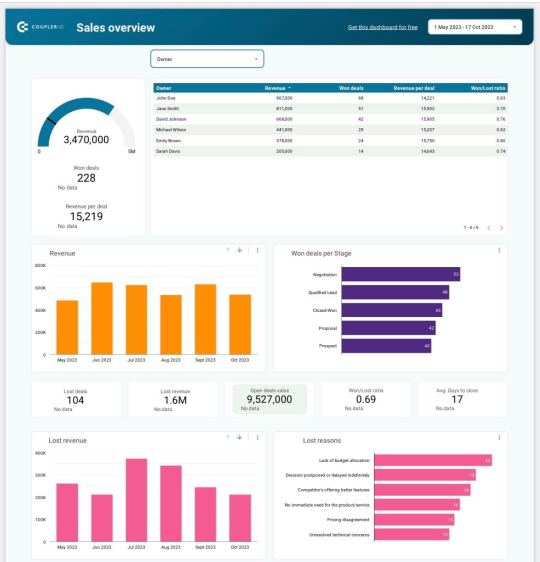
Sales reporting dashboards are integral to sales strategy, enabling data-driven decision-making. They are vital in tracking performance, setting targets, and identifying trends to enhance overall business performance.
Creating a dashboard is straightforward—options include using templates, building from scratch, or seeking professional assistance.
If you want to explore more, see the details on how to create a Looker Studio sales dashboard.
#dashboard templates#data visualization#data analytics#dashboards#sales data#sales dashboards#looker studio#reporting#data automation
1 note
·
View note
Text
11 Best Looker Studio Marketing Dashboards for Reporting
Generating reports play a vital role in the overall marketing strategy. Raw data cannot alone provide meaningful insights without proper interpretation and analysis. Yet, the process of crafting dashboards and reports can be daunting, particularly when data gathering and entry are manual tasks. However, before delving into sharing some of the finest, user-friendly, and cost-free templates for Looker Studio, let’s first explore the primary advantages of employing these marketing reporting dashboards.
Advantages of Looker Studio Marketing Reporting Dashboards
Enhanced Data Visualization: Looker Studio marketing reporting dashboards offer graphs, charts, and other visual elements for easy comprehension and sharing with stakeholders or managers.
User-Friendly: Our templates are pre-configured with essential metrics for various activities or channels, requiring you only to connect your data source (e.g., Google Analytics, YouTube, Facebook Ads) to Looker Studio for easy data export and modification.
Customizability: Tailor the marketing reporting dashboard to your specific needs by adjusting or omitting metrics as required.
Collaboration and Sharing: Share these dashboards with managers, clients, and team members for collaborative insights and data contributions.
Cost-Effective and Efficient: Many Looker Studio templates are free or offer budget-friendly monthly subscriptions. This efficient approach saves you time compared to manual data collection and entry.
11 best Looker Studio marketing dashboards
Facebook Ads dashboard by Coupler.io
Google Ads dashboard by Coupler.io
SEO Dashboard by DataSasi
LinkedIn Ads dashboard by Coupler.io
Multichannel Dashboard by IntelliAd
Search Console Dashboard by Google
Digital Analytics Dashboard for eCommerce by Treffsikker
YouTube Dashboard by YouTube
BigQuery Firebase Events Dashboard By Google
Site Speed Performance Dashboard by DataBloo
Web Analytics Dashboard by Coupler.io
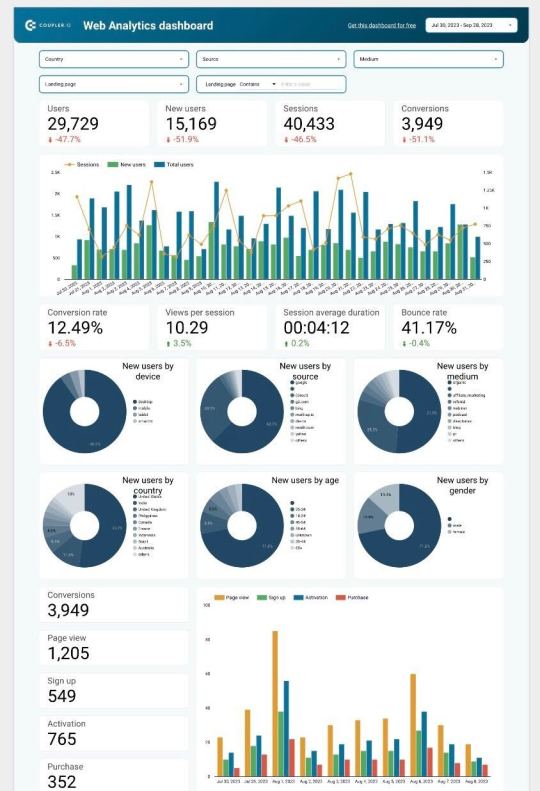
#digital marketing#dashboard templates#data visualization#data analytics#dashboards#looker studio#marketing dashboards#reporting#automation#marketing analytics#business analytics#marketing reporting
1 note
·
View note
Text
Enhancing CRM Efficiency with Custom Dashboards
As implied by its name, CRM dashboards serve to enhance the organization of the customer relationship management process. While CRM tools typically come equipped with built-in dashboards, these may only allow for a limited amount of customization. Consequently, it can often be more advantageous to construct a tailored dashboard using a dedicated data visualization tool like Looker Studio or Power BI. For instance, you can utilize this dashboard as a foundation, swiftly generate your data visualizations, and then adapt them to your preferences by leveraging the robust features available within Looker Studio. Discover more about the limitless possibilities for tailoring your data insights to suit your exact needs and make data-driven decisions with unparalleled precision.
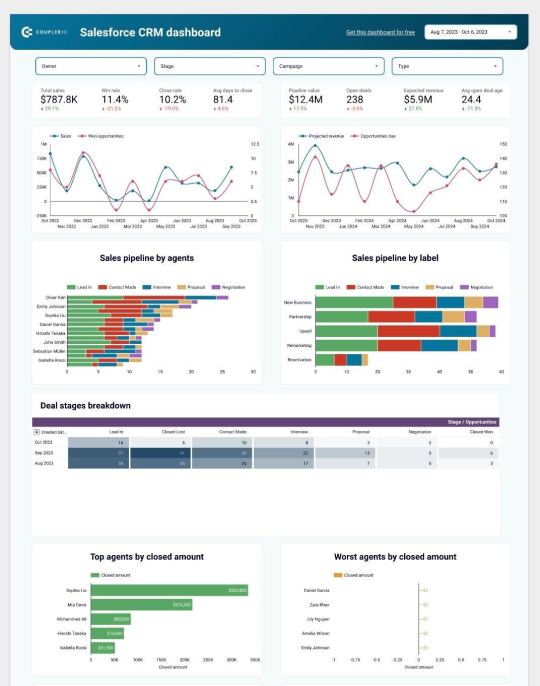
These CRM dashboard templates are available for different apps — Salesforce, Pipedrive, HubSpot, and others. If you use one of these apps, I recommend trying the templates: Hubspot CRM dashboard Pipedrive CRM dashboard Salesforce CRM dashboard
In conclusion, harnessing specialized data visualization dashboard tools like Looker Studio can empower businesses to create highly customizable CRM dashboards, facilitating more effective customer relationship management and data-driven decision-making.
#dashboard templates#data visualization#data analytics#dashboards#marketing dashboards#digital marketing#crm#customerexperience#crm dashboards#hubspot#pipedrive#salesforce#looker studio#customer relationship management#power bi
0 notes
Text
Unlock Your Business Potential with KPI Dashboards: Get Started with Free Templates
KPI dashboards are like the navigational compass for organizations, honing in on the metrics that matter most. They're the go-to tool for managers, supervisors, and other key stakeholders to keep a close eye on how well the organization is doing and where it can do even better. Think of them as the "show-and-tell" of data, where you'll find sales figures, production metrics, inventory levels, employee performance, customer service metrics, etc. These dashboards are your personalized cheat sheet for business success. #KPIdashboards are different from other types of #dashboards, such as operational, strategic, or analytical dashboards, as they focus on specific key performance indicators and on tracking progress toward specific goals.
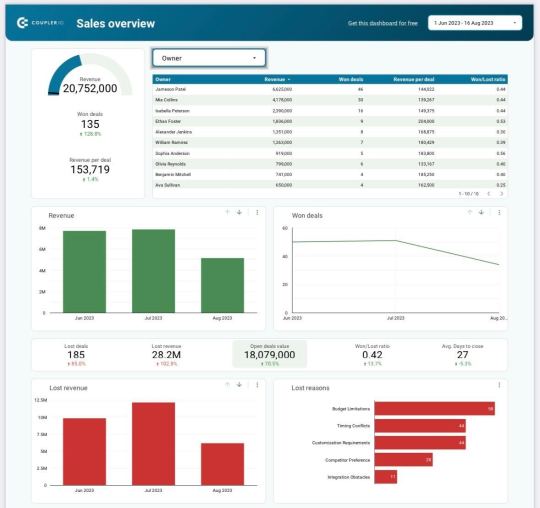
This dashboard is available as a free template. You can use it to visualize your sales data automatically in just a few minutes.
Grab these free sales KPI dashboard templates:
Hubspot Sales KPI Dashboard Template
Pipedrive Sales KPI Dashboard Template
Salesforce Dashboard Template
KPI dashboards play a pivotal role in ensuring that organizations stay on course toward their objectives. By focusing on critical metrics and goal tracking, these tools empower leaders to make informed decisions and drive continuous improvement. Their distinctiveness lies in their commitment to quantifiable success, making them indispensable in the modern business landscape. Click here to find other dashboard examples that can ease your daily efforts.
#digital marketing#dashboards#data analytics#data visualization#marketing dashboards#sales data#sales dashboards#kpi dashboard#kpi metrics#kpi#dashboard templates
0 notes
Text
Navigating Real-Time Operations: The Power of Operational Dashboards
Operational dashboards are dynamic visual interfaces that provide real-time insights into an organization's day-to-day activities and performance. These dashboards are particularly valuable for monitoring short-term operations at lower managerial levels, and they find application across various departments. They stand as the most prevalent tools in the realm of business intelligence.
Typically, operational dashboards are characterized by their comprehensive nature, offering junior managers detailed information necessary to respond to market dynamics promptly. They also serve to alert upper management about emerging trends or issues before they escalate. These dashboards primarily cater to the needs of managers and supervisors, enabling them to oversee ongoing activities and make rapid decisions based on the presented information. Operational dashboards often employ graphical representations like graphs, charts, and tables and can be customized to display information pertinent to the specific user.
Examples of data typically showcased on an operational dashboard include:
Sales figures
Production metrics
Inventory levels
Service levels
Employee performance metrics
Machine or equipment performance data
Customer service metrics
Website or social media analytics
It is crucial to emphasize that operational dashboards are distinct from other dashboard types, such as strategic and analytical dashboards. These different dashboards serve varied purposes and audiences and contain dissimilar datasets and metrics. Here are a couple of examples.
Below, you can see a Revenue overview dashboard for QuickBooks. It provides month-by-month overviews of invoices, products, customers, profit and loss. Such a dashboard can be used on a daily basis and help monitor and manage operating activities.
This data visualization is connected to a data automation solution, Coupler.io. It automatically transfers fresh data from QuickBooks to the dashboard, making it auto-updating. Such a live dashboard can be an important instrument for enabling informed decision-making.
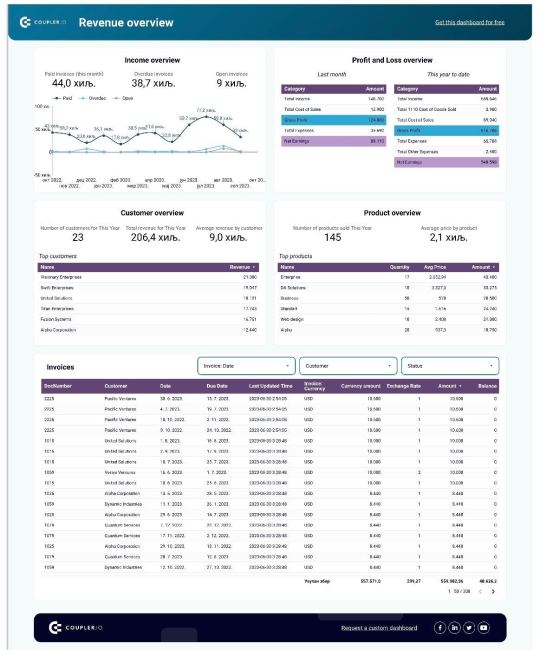
This Revenue overview dashboard is available as a free template. Open it and check the Readme tab to see how to use it.
Here’s another example of an operational dashboard, the Facebook Ads dashboard. It allows ad managers to closely track their ad performance. This dashboard is also powered by Coupler.io, so it depicts ad data in near real-time. This allows marketers to quickly define what works and what doesn’t and make adjustments on the go.
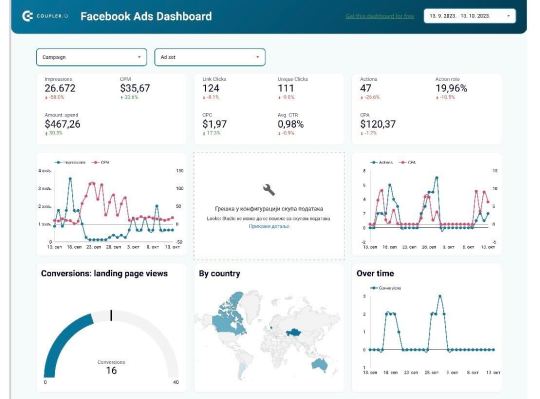
Facebook Ads dashboard is available as a free template. You can grab it and quickly get a copy of this dashboard with your data. In conclusion, operational dashboards are indispensable tools for organizations seeking to thrive in a dynamic business landscape. These real-time visual displays offer invaluable insights into day-to-day operations, equipping managers and supervisors with the information to make swift, informed decisions. As the most widely used business intelligence instruments, operational dashboards empower businesses to adapt to market changes, identify emerging trends, and maintain a competitive edge. Their versatility and capacity to monitor a wide range of metrics make them an essential asset for managing the intricacies of modern operations.
#marketing dashboards#digital marketing#dashboards#data analytics#data visualization#operational dashboards
2 notes
·
View notes